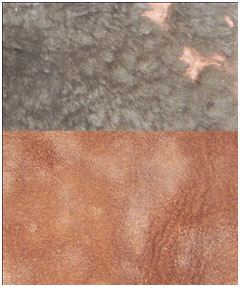Sheep Lice
Lice are external parasites which either suck the blood or feed off the skin of their host. Their biggest impact is on the decrease to the quantity and quality of the fleece as well as causing “cockle”. Lice are species specific and small enough they are often hard to detect with the naked eye. It is recommended that if you wear reading glasses while reading you wear them when inspecting your animals for lice. There are three types of lice to look for in your sheep flock. These include:

Figure 1: Damage - Both sides of pelt after tanning.
- Bovicola ovis, a biting body louse, which is found over the back & flanks in fleece covered areas. The most common worldwide.
- Linognathus ovillus, the face and body louse or sucking body louse, these may be found on any part of the sheep except the limbs.
- Linognathus pedalis, the foot louse, also a sucking louse which as the name implies is found on the feet and may spread upward on the limbs and lower abdomen.
There are several very good websites which document the life cycle, images of lice, as well as surveillance, treatment and control protocols. Rather than recreate these we will note our picks at the bottom of this article for further reading. The best of these come out of Australia, whereas the insecticides are noted but particular brand names may not be locally available. We will follow with just a few comments we feel are important to remember.
- Pyrethroids work well when treating lice but may take up to 6 weeks to fully translocate over the entire sheep’s body, especially in longer wooled animals.
- Transfer of lice to the lambs may occur if treatment of the ewe is less than 6 weeks prior to lambing.
- Organophosphates also work well for treatment and control of louse infestations in sheep.
- Always follow label directions.
- For proper placement and dilution when required.
- Note slaughter withdrawal periods.
- Warnings which may apply to the age of lambs that the product should not be used.
- Proper protective equipment that should be worn at the time of application and handling of recently treated animals.
Prepared by Cleon V. Kimberling, Gerilyn A. Parsons, Jay Parsons, and
Wayne Cunningham
Optimal Livestock Services, LLC
970-231-2477
Copyright © 2011 CleonsCorner.com All Rights Reserved
